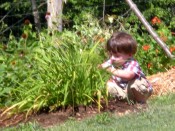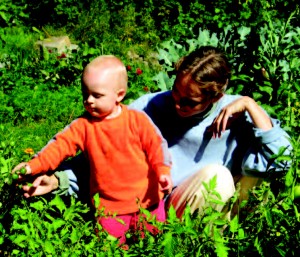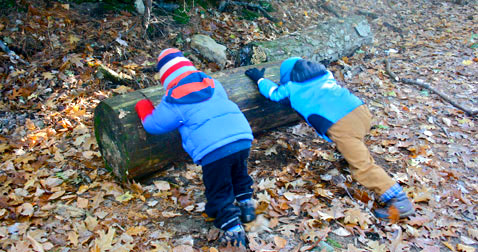Waldorf News
Social Development in the Very Young Child

By SUSAN WEBER
Few areas of children’s development bring us more questions than their social and emotional development. Perhaps it is because we know that this is an extremely complex area of human development, fraught with sensitivity; perhaps we are also aware of its central place in life’s journey. We carry our social selves into every situation of life, and as contemporary psychologist and researcher Daniel Goleman has confirmed, our social capacities far outweigh our cognitive ones in determining success and satisfaction in our lives. It is also the area in which we have so much to contribute to the future of humanity; in addressing the world’s most complex problems. This is the realm in which our soul forces – thinking, feeling, and willing – intersect, and require balance and inner development to manifest their potential.
But where do these capacities begin? It is a long journey from infancy to a maturity of our social capacities that enables us to wear a garment that aligns our social capacities with our spiritual hopes and intentions – that enables us to walk through daily life meeting the world out of our best selves.
As both parents and teachers, we are surrounded by societal expectations around the social capacities of our children. How do we prepare the children for the world in which they live, giving them age appropriate guidance that meets their needs? How do we develop the virtues of generosity and compassion that make us fully human? How do we meet conflict healthily in our both conflict ridden and conflict averse world?
From several perspectives, we may recognize that these are processes that only unfold over time. The expectations we hold, the approach we bring to children in the early years is highly dependent upon their stage of development. Appropriate expectations for a two year old will differ greatly from those for a four year old, and from those for ourselves as adults. As we become increasingly aware of the children’s subtle developmental stages and develop our capacity for observation, we can support them more successfully.
In guiding children into social life in the early childhood years, there are three aspects out of which we build a secure and rhythmic environment for them.
The first is imitation, the underlying and guiding principle of young children’s learning. Imitation stands first and foremost as the means by which children learn the virtues that will support them for their entire lives: reverence and gratitude. Our hope and task is to bring them, through our own example of reverence and gratitude, a feeling in their wills that will enable them to live with these two virtues throughout their lives in an active way. By respecting this area of the child’s spiritual freedom we offer a gift for his entire life.
Rudolf Steiner describes this phenomenon in the following way:
And yet gratitude is a virtue that, in order to play a proper role in the human soul, must grow with the child. Gratitude is something that must already flow into the human being when the growth forces—working in the child in an inward direction—are liveliest, when they are at the peak of their shaping and molding activities. Gratitude is something that has to be developed out of the bodily-religious relationship I described as the dominant feature in the child from birth until the change of teeth. At the same time, however, gratitude spontaneously during this first period of life, as long as the child is treated properly. All that flows, with devotion and love, from a child’s inner being toward whatever comes from the periphery through the parents or other educators—will be permeated with a natural mood of gratitude. We only have to act in ways that are worthy of a child’s gratitude and it will flow toward us, especially in the first period of life. This gratitude then develops further by flowing into the forces of growth that make the limbs grow, and that alter even the chemical composition of the blood and other bodily fluids. This gratitude lives in the physical body and must dwell in it, since otherwise it would not be anchored deeply enough.*
I am quoting at length, because of the mis-perception that gratitude may be equated with social habit or manners. While we do, in fact, work in the realm of social habit, this is not the realm of the virtues of gratitude and reverence in which the child’s spiritual freedom must be allowed to be active, as Steiner so clearly describes in the passage above.
 The capacity for compassion, for entering into the suffering of another human being with true empathy, is a highly evolved one and a capacity that Rudolf Steiner shares will only be fully developed in the far distant future. For the young child, it is only the tenderest beginning that shows itself for his own self is just finding a home as he begins to refer to himself as ‘I’, as he begins to be a distinctive individual with his own biography and life story. Surely it is first that we learn to know ourselves before we can see the other through the eyes of compassion. We may see in even babies a hint of empathy when the other child cries, or expresses feelings through facial expression. But whether these are learned capacities or innate gifts is difficult to know. Further and of importance in developing appropriate expectations of young children, is to consider whether this a capacity that the outside world can call upon or is whether this is a tiny spark of an essentially nascent capacity that will be available to the child only later in life, one that we do not wish to draw upon prematurely in a conscious teaching or expectation.
The capacity for compassion, for entering into the suffering of another human being with true empathy, is a highly evolved one and a capacity that Rudolf Steiner shares will only be fully developed in the far distant future. For the young child, it is only the tenderest beginning that shows itself for his own self is just finding a home as he begins to refer to himself as ‘I’, as he begins to be a distinctive individual with his own biography and life story. Surely it is first that we learn to know ourselves before we can see the other through the eyes of compassion. We may see in even babies a hint of empathy when the other child cries, or expresses feelings through facial expression. But whether these are learned capacities or innate gifts is difficult to know. Further and of importance in developing appropriate expectations of young children, is to consider whether this a capacity that the outside world can call upon or is whether this is a tiny spark of an essentially nascent capacity that will be available to the child only later in life, one that we do not wish to draw upon prematurely in a conscious teaching or expectation.
An example of this might be the request to the child to express that he is sorry for something that he did that may have caused discomfort to another. In the child under perhaps age five – and in some children only later – there may not even be awareness that, in fact, discomfort was caused by his activity. Awareness of cause and effect are not early capacities!
What we can do as adults is to model the response that we would hope the child can later offer out of himself. We can strive to be a living example of compassion again and again, offering the healing gesture that the child can not yet offer out of himself.
The foundation for our work with children in the first seven years wants to stand firmly grounded in this understanding. We cannot teach these virtues, nor can we train gratitude through the social habits of manners. Good manners are culturally determined and vary greatly throughout the world – think of the difference among cultures in eating habits where in some cultures it is expected that one eats with ones fingers, while in other places this would be the greatest breech of etiquette.
These culturally determined habits stand in contrast to virtues that are spiritually and universally rooted. The culturally determined social capacities flow through the path of imitation of the adults in the child’s life, and later, we hope that the child will have developed the sensitivity to recognize when he is in an environment in which these need to be modified or changed altogether. The virtues of reverence, gratitude, and compassion remain forever universal.
In addition to the these central human virtues – the path of reverence and gratitude – we are entering into a second area in which we work as early childhood teachers to develop the healthy social capacities in the very young child. This is the area in which we support the development of the child’s self initiated compliance. This is the area in which we strive to offer the child opportunities within daily life in which he comes gradually toward socially mature behavior out of his own initiative, learning through the exercise of habit, through the activity within his choice, to respond to the guidance and example around him. Social manners fall into this area, as does the early learning to respond to behavioral expectations – dressing oneself, washing ones hands, returning from outdoor play when the transition time comes. There are innumerable such moments throughout the day which we make use of in strengthening the child’s will to flow through time and space as part of a social group.
Working sensitively in this area strengthens resilience and flexibility, the capacity to cope with frustration, and to meet the limitations of the world in which the child lives. These strengths are supported and are developed through the clarity of the adult’s thought and will: developing healthy rhythms that take into consideration the developmental stages of the child or children, the physical environment, and utilizing the foundational principles of rhythm and repetition.
Conflict
A further area of social experience for the very young child is that of conflict. Eva Kallo, psychologist and pedagogical support staff member of the Pikler Institute in Budapest, describes conflict as a natural coinciding of interests and therefore an inevitability in life. But without skills in meeting conflict, it easily becomes a source of discomfort or avoidance. How can we prepare our children to later meet conflict with age-appropriate skills, with a recognition that conflict is a potential source of creativity?
Living and working with toddlers puts us on the forefront of this question, for as they begin to feel themselves as individuals, literally meeting the world with the creative tension of self discovery, conflict is a necessary effect as each child strives to understand what happens as she reaches out to encounter the world with the force of her being. How we respond gives the child a picture of his effect on the world around her and begins to mold his actions in a positive way.
We also encounter as adults with very young children the area in which the adult leads and guides the children’s behavior with firmness and clarity, setting clear, objective boundaries around unacceptable social behavior. This may well be defined through three principles that the teacher or parent both models and enforces through word and deed when necessary, without hesitation or apology, that:
•The child may not hurt another person (child or adult)
•The child may not hurt, damage, or destroy the physical environment
•The child may not harm themselves
The more clearly and unapologetically these principles are brought to the child and lived around her, the more easily the child can imitate and build healthy habits for life. The child is then increasingly free in her social life and interactions with the world around her, because these habits create a framework for play, for friendship, for work.
It is highly helpful to recognize that there are differentiated and mutually supportive areas in which the child grows into becoming a social being who lives in freedom, with grace, and in comfortable relationship with the other human beings around him. She will have a joy in daily life that grows with increasing practice of these capacities and in the experience of the empathy of adults around, as she tenderly unfolds the beginnings of social capacities.
 Susan Weber is the Director of Sophia’s Hearth Family Center. She brings many years as a Waldorf early childhood teacher, public school teacher and administrator, Waldorf early childhood training coordinator at Antioch University New England, and adult educator. Susan is involved in international work in Waldorf early childhood teacher training. She has completed advanced training at the Pikler Institute in Budapest, Hungary. She regularly presents the work of Sophia’s Hearth Family Center – as well as themes relating to the very young child – at local, national and international conferences. She is the director of Sophia’s Hearth Family Center’s 13-month training professional development course, “The Child and Family in the First Three Years,” and facilitates Sophia’s Hearth Family Center’s Joyful Beginnings parent-child playgroups. Learn more about Sophia’s Hearth Family Center here.
Susan Weber is the Director of Sophia’s Hearth Family Center. She brings many years as a Waldorf early childhood teacher, public school teacher and administrator, Waldorf early childhood training coordinator at Antioch University New England, and adult educator. Susan is involved in international work in Waldorf early childhood teacher training. She has completed advanced training at the Pikler Institute in Budapest, Hungary. She regularly presents the work of Sophia’s Hearth Family Center – as well as themes relating to the very young child – at local, national and international conferences. She is the director of Sophia’s Hearth Family Center’s 13-month training professional development course, “The Child and Family in the First Three Years,” and facilitates Sophia’s Hearth Family Center’s Joyful Beginnings parent-child playgroups. Learn more about Sophia’s Hearth Family Center here.
 Waldorf Training in Australia
Waldorf Training in Australia Middle School Science With Roberto Trostli
Middle School Science With Roberto Trostli Training in Traumatology & Artistic Therapies
Training in Traumatology & Artistic Therapies Bay Area Teacher Training
Bay Area Teacher Training Great books for Waldorf Teachers & Families
Great books for Waldorf Teachers & Families Jamie York Books, Resources, Workshops
Jamie York Books, Resources, Workshops Quality Education in the Heartland
Quality Education in the Heartland Everything a Teacher Needs
Everything a Teacher Needs Immersive Academics and Arts
Immersive Academics and Arts Caring for All Stages of Life
Caring for All Stages of Life The Journey is Everything
The Journey is Everything Transforming Voices Worldwide
Transforming Voices Worldwide Preparing Teachers for 2024-25 Grades 1-8
Preparing Teachers for 2024-25 Grades 1-8 Space speaks. Its language is movement.
Space speaks. Its language is movement. Grade Level Training in Southern California
Grade Level Training in Southern California Flexible preparation for your new grade
Flexible preparation for your new grade Summer Programs - Culminating Class Trips
Summer Programs - Culminating Class Trips Association for a Healing Education
Association for a Healing Education ~ Ensoul Your World With Color ~
~ Ensoul Your World With Color ~ Enliven Your Teaching!
Enliven Your Teaching! Roadmap to Literacy Books & Courses
Roadmap to Literacy Books & Courses Waldorf-inspired Homeschool Curriculum
Waldorf-inspired Homeschool Curriculum Waldorf Stories for Everyone
Waldorf Stories for Everyone Bringing Love to Learning for a Lifetime
Bringing Love to Learning for a Lifetime Grade-specific web courses for teachers
Grade-specific web courses for teachers Full-Time Teacher Education
Full-Time Teacher Education Train to Teach in Seattle
Train to Teach in Seattle
 RSS Feeds
RSS Feeds